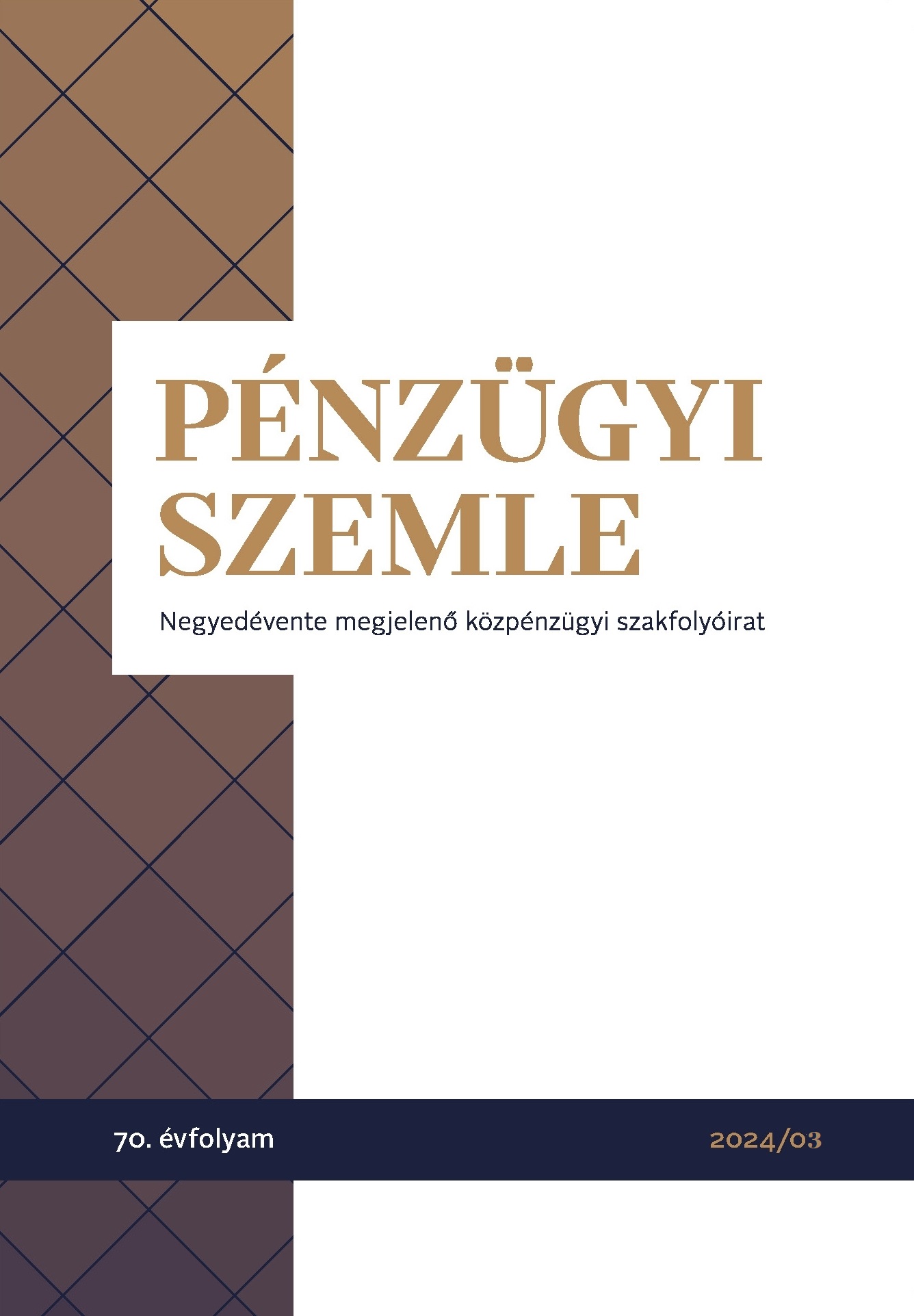The inflation situation in Hungary
Response to Katalin Botos „Inflation and our finances” and István Ábel – Gergely Bognár – Máté Lóga – Attila István Szabó „Changes in the explanation of inflation”
DOI:
https://doi.org/10.35551/PFQ_2024_3_5Keywords:
inflation, monetary policy, interest rate policy, food inflation, E31, E52, E58Abstract
The article examines the factors driving inflation in 2022-2023. We explore why inflation in the Hungarian economy has risen more sharply compared to neighboring countries with similar economic structures. The goal of the article is to highlight these factors and provide policymakers with recommendations for a more resilient inflation policy.
First, we respond to Katalin Botos’ views on inflation, and then we analyze some global inflationary trends. Our study focuses specifically on inflation in the agricultural sector.
Our findings indicate that, in addition to global cost-push inflationary pressures, several country-specific factors have contributed to the rise in domestic inflation. Energy prices have surged, and some supply chains in the East have been disrupted. For Hungary’s less productive but energy-intensive food industry, the energy price shock, combined with higher exchange rate volatility in 2022-2023 compared to neighboring countries, has had a strong impact in the short to medium term, causing significant deviations from long-term equilibrium. In our view, beyond enhancing food self-sufficiency, special attention should be given to the domestic development of the agricultural supply chain.
References
AKI 2023: Az élelmiszer-gazdaság külkereskedelme, XXVII. évfolyam • 1. szám • 2024. szám https://www.aki.gov.hu/termek/az-elelmiszer-gazdasag-kulkereske delme-2023-ev/
Arndt, R. Benfica, N. Maximiano, A.M. Nucifora, J. Thurlow Higher fuel and food prices: impacts and responses for Mozambique Agric. Econ., 39 (2008), pp. 497- 511; https://doi.org/10.1111/j.1574-0862.2008.00355.x
Auer, R. A., Levchenko, A. A., & Sauré, P. (2019). International inflation spillovers through input linkages. Review of Economics and Statistics, 101(3), 507-521.; DOI 10.3386/w23246
Ábel I. – Bognár G. – Lóga M. – Szabó I. A. (2024) Változások az infláció magyarázatában. Pénzügyi Szemle 2024/1. szám; DOI: https://doi.org/10.35551/ PFQ_2024_1_6
Bareith T. – Fertő I. (2023). Stabilizálhatja-e a monetáris politika az élelmi szer-inflációt? Statisztikai Szemle 101, évfolyam 4. szám, pp. 354-380.; https:// doi.org/10.20311/stat2023.04.hu0354
Bareith, T. - Csonka, A. (2022) „Dynamics of Competition in the Hungarian Poult-ry Industry”, AGRIS on-line Papers in Economics and Informatics, Vol. 14, No. 2, pp. 15-29. ISSN 1804-1930. DOI 10.7160/aol.2022.140202.
Barrett, C. D., P.A. Dorosh Farmers’ welfare and changing food prices: nonpa rametric evidence from rice in Madagascar Am. J. Agric. Econ., 7 (3) (1996), pp. 656-669
Bareith, T. - Csonka, A. (2019) Profitperzisztencia vizsgálata a magyar ser-tésszek torban. KÖZGAZDASÁGI SZEMLE, 66 (7-8). pp.; http://dx.doi.org/10.18414/ KSZ.2019.7-8.847
Botos, K. (2023) Infláció és pénzügyeink. PÉNZÜGYI SZEMLE/PUBLIC FINAN CE QUARTERLY (1963-), 69 (4). pp. 84-94. ISSN 0031-496X; DOI: https://doi. org/10.35551/PFQ_2023_4_5
Goodhart, C. – Pradhan, M. (2017) Demographics will reverse three multide cade global trends. Letöltés dátuma: 2022.11.20. http://eprints.lse.ac.uk/84208/1/ Goodhart_Demographics%20will%20reverse_2017.pdf
Cravino, J., & Levchenko, A. A. (2017). Multinational firms and international busi ness cycle transmission. The Quarterly Journal of Economics, 132(2), 921-962.; DOI:10.1093/qje/qjw043
Fellner Á (2023): Megbukott az unortodox gazdaságpolitika. https://utodaink-jo voje.hu/ gazdasag/az_unorthodoxia_kudarca.pdf
Hajnal M. – Várhegyi J. (2016) Infláció. Letöltés dátuma: 2022.10.16. https://www. mnb.hu/letoltes/mnb-oktatasi-fuzetek-inflacio-2016majus.pdf
Karsai, G. (2023). GKI Gazdaságkutató Zrt.: Idén 0, 5 százalékos visszaesés és 19 százalékos infláció várható. KÜLGAZDASÁG, 67(3-4), 32-52.; https://doi. org/10.47630/KULG.2023.67.3-4.32
Kharroubi, E., & Smets, F. (2024). Monetary policy with profit-driven inflation (No. 1167). Bank for International Settlements.
KSH 2024a: Korfa; Letöltve 2024.04.21 https://www.ksh.hu/interaktiv/korfak/ orszag.html
KSH 2024b: A fogyasztóiár-index fogyasztási főcsoportok szerint és a nyugdíjas fogyasztóiár-index; Letöltve 2024.04.03. https://www.ksh.hu/stadat_files/ara/ hu/ara0002.html
KSH 2024c Infláció radar 2022. december Fogyasztóiár-indexek a kiadások cso portjai szerint Letöltve 2024.04.03. https://www.ksh.hu/interaktiv/fogyar_radar/ index.html
Molnár György 2014: Miért lehet magasabb az érzékelt infláció a valóságnál? https://www.mnb.hu/letoltes/molnar-gyorgy-miert-lehet-magasabb-az-erze kelt-inflacio-a-valosagnal.pdf)
MNB 2023 Inflációs jelentés 2023. december. https://www.mnb.hu/letoltes/ hun-ir-digitalis-24.pdf; 50. oldal
MNB 2024a: Euro árfolyam Letöltés dátuma: 2024.03.07. https://www.mnb. hu/arfolyam-tablazat?deviza=rbCurrencySelect&devizaSelected=EUR&date from=2018.+02.+07.&datetill=2024.+03.+07.&order=1
MNB 2024b: Gyorselemzés az infláció alakulásáról. 2024. Február Letöltés dátu ma: 2024.03.01.
MNB 2024c: Az élelmiszerek fogyasztási súlya az infláció mérésében MNB sze rinti bontás; https://statisztika.mnb.hu/idosor-3678; 0203_mnbcsoportok ; Letöltés dátuma: 2024.03.01.
Matolcsy Gy. – Nagy M. – Palotai D. – Virág B. (2020) Infláció a digitális korban – Az infláció mérése és torzításai a 21. században. HITELINTÉZETI SZEMLE / FINANCIAL AND ECONOMIC REVIEW, 19 (1). pp. 5-36. ISSN 1588-6883 http:// doi.org/10.25201/HSZ.19.1.536
Moses K. Tule, Afees A. Salisu, Charles C. Chiemeke, Can agricultural commo dity prices predict Nigeria’s inflation?, Journal of Commodity Markets, Volume 16, 2019, 100087,ISSN 2405-8513, https://doi.org/10.1016/j.jcomm.2019.02.002.
Moncarz, P; Barone, S.; Descalzi, R. Shocks to the international prices of agricultu-ral commodities and the effects on welfare and poverty: a simulation of the exante long run effects for Uruguay Int. Econ., 156 (2018), pp. 136-155 December 2018
Nagy É. – Tengely V. (2018) The external and domestic drivers of inflation: the case study of Hungary. BIS Paper, (100j).. doi: 10.31477/rjmf.201803.49 2
Sipiczki, Z. - Parádi-Dolgos, A. - Varga, J. (2023) Analysis of the inflationary re distribution of consumption and wealth, evidence from Hungary. ACTA OECO NOMICA, 73 (1). pp. 129-143. ISSN 0001-6373
Spéder B. – Vonnák B.: Inflációs sokkok és dezinfláció: stilizált tények az elmúlt 50 év alapján Hitelintézeti Szemle, 22. évf. 3. szám, 2023. szeptember, 26–47. o.; https://doi.org/10.25201/HSZ.22.3.26
Petschnig, M. Z. (2023). 2022: Határozott inflációerősödés, főként belső okokból. KÜLGAZDASÁG, 67(1-2), 130-135. https://real.mtak.hu/180842/1/K16_Pet schnig_d1ec8be9f1.pdf; https://doi.org/10.47630/KULG.2023.67.1-2.130
Várhegyi, É. (2023). Hiteltelen politika, beragadó infláció. KÜLGAZDASÁG: A KOPINT KONJUNKTÚRA KUTATÁSI ALAPÍTVÁNY FOLYÓIRATA, 67(1-2), 164-168. https://real.mtak.hu/180374/1/K20_Varhegyi_800268d371.pdf; https:// doi.org/10.47630/KULG.2023.67.1-2.164
/2022. (I. 14.) Korm. rendelet az árak megállapításáról szóló 1990. évi LXXXVII. törvény veszélyhelyzet ideje alatt történő eltérő alkalmazásáról
Downloads
Published
How to Cite
Issue
Section
License
Copyright (c) 2024 Public Finance Quarterly

This work is licensed under a Creative Commons Attribution 4.0 International License.
Authors assign copyright to Pénzügyi Szemle / Public Finance Quarterly. Authors are responsible for permission to reproduce copyright material from other sources.












